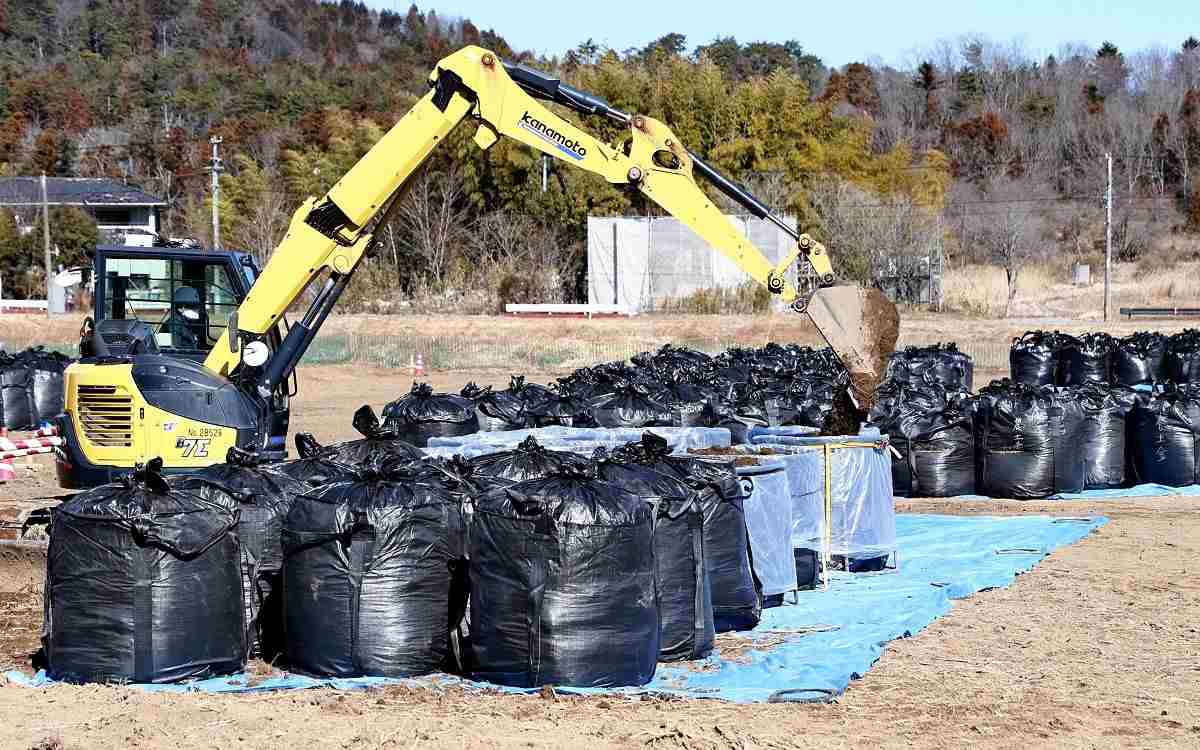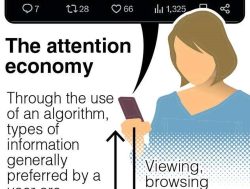13 Years Since the Great East Japan Earthquake / Soil Decontamination Advancing in Fukushima Pref.; More Evacuees Able to Return Home, But Not Many Do

Decontamination work is in progress at a specified living area for returnees in the town of Okuma, Fukushima Prefecture, in mid-February.
The Yomiuri Shimbun
7:00 JST, March 8, 2024
This is the third installment of a series that explores the current reality in areas affected by the 2011 Great East Japan Earthquake.
***
“I wish we had been allowed to return home a little earlier,” lamented Takeshi Horikawa, 75, who has been living as an evacuee in the city of Iwaki, Fukushima Prefecture. Horikawa is from the town of Okuma, which was designated as a difficult-to-return zone following the 2011 Fukushima No. 1 nuclear power plant accident triggered by the Great East Japan Earthquake.
He has been regularly visiting Okuma to mow his yard, but the fields once devoted to rice and other crops have gone to ruin, and he plans to tear the house down soon.
Once the evacuation order has been lifted, he plans to build a cottage for overnight visits to the site.
Within difficult-to-return zones, work is underway in some places to remove 10 centimeters of topsoil from farmland with heavy machines. The government has designated the houses and farmland of people wishing to return home in those areas, as well as the roads, as “Specified Living Areas for Returnees” and began decontamination work in the towns of Okuma and Futaba ahead of other municipalities at the end of last year.
Radiation levels at the site were already down to 2.3 microsieverts per hour, below the government-set criterion of 3.8 microsieverts per hour for lifting evacuation orders, in December, when the decontamination work started. Decontamination personnel wore ordinary work clothes while using high-performance respirators, rather than wearing a full suit of white protective gear.
It was initially said that people would not be able to live in difficult-to-return zones for a long time due to high radiation levels. But the levels have dropped with the passage of time, reaching a point at which efforts toward allowing people to return home can be made.
In response, the government first set up “Specified Reconstruction and Revitalization Base Areas,” where it places priority on decontamination efforts. Since 2022, evacuation orders for such districts have been lifted in six municipalities: Okuma, Futaba, Namie, Tomioka, Katsurao and Iitate.
As the next step, the government set up the specified living areas for those wishing to return home, which are separate from the specified reconstruction and revitalization areas. Currently, the areas are located in Okuma, Futaba, Namie and Tomioka towns. The government aims to lift evacuation orders in these areas during the 2020s.
There are still 309 square kilometers of land designated as difficult-to-return zones, accounting for about 27% of the land in seven municipalities. Specified Living Areas for Returnees in the four towns account for 4.6% of that, or 14.2 square kilometers. It can be said that a system designed to enable residents to return home has entered the “final phase.”
Following the 2011 nuclear accident, evacuation orders were issued in 11 municipalities. With the evacuation orders gradually lifted in some areas since 2014, the municipalities have become divided into zones where the orders were lifted and zones that are still covered by the orders.
In one district in Okuma, the evacuation order was lifted for its south side in 2022 as it was designated a district for reconstruction and revitalization. But the order remained in place for the north side, where Horikawa’s house is located. Once the government established the system for specified living areas, the town government filed an application to designate the north side as such an area in an effort to revitalize the community.
However, many people have yet to return home in affected areas. Even after evacuation orders had been lifted for districts for reconstruction and revitalization, only 18.8% of registered residents were living in the areas in 11 municipalities.
The situation appears similar in specified living areas. Of 604 households in such districts in Okuma, only 198 households, or 32.8%, expressed a wish to return home. The figure is between 20% and 40% in three other towns.
Even among those who expressed such a wish, the number who will actually return home is believed to be even lower. This is because it includes the elderly, those in poor physical condition, those seeking decontamination work only so they can demolish their houses, and those without enough money to rebuild their houses.
Evacuation orders were lifted for 90% of the land in Tomioka, but the site where Noboru Fukaya’s house once stood remained part of the difficult-to-return zone.
“The evacuation order was lifted for my neighbor’s place, just across the street,” said Fukaya, 71. “I really envied them.”
Although the site became a specified living area, he and his wife have already built a house in Iwaki, to which they evacuated after the disaster, and their grandchild was born.
As his wife, 62, does not want to return to Tomioka, Fukaya said, “It’s already too late to lift the evacuation order.”
Popular Articles
Popular articles in the past 24 hours
-

AI Personalizes Foreign Language Lessons in Pilot Projects, Inspi...
-

Bank of Japan Considered U.S. Tariffs, Coming Shunto Wage Hike Ta...
-

Green Expo 2027 Gains Attention from Osaka Expo Fans; Event Plann...
-

Japan's 1st Domestically Manufactured EV Police Motorcycle Unveil...
-

Kumamoto: Trams to Continue Accepting IC Cards after Strong Oppos...
-

Yen Weakens against Peers after BOJ Raises Interest Rates
-

Coffee Omakase Is Japan's Love Letter to Caffeine
-

Colorful New Year Lucky Charm Production Reaches Peak in Shizuoka...
Popular articles in the past week
-

University of Tokyo Professor Discusses Japanese Economic Securit...
-

Tsukiji Market Urges Tourists to Avoid Visiting in Year-End
-

Israeli Tourists Refused Accommodation at Hotel in Japan’s Nagano...
-

China to Impose Sanctions on Shigeru Iwasaki, Former Head of Japa...
-

Japan to Support Central Asian Logistics Route That Bypasses Russ...
-

U.S. Senate Resolution Backs Japan, Condemns China's Pressure
-

Speed Skater Yukino Yoshida Clinches Ticket to Milan
-

Kenta Maeda Joins Rakuten Eagles; Returns from American MLB to Ja...
Popular articles in the past month
-

Keidanren Chairman Yoshinobu Tsutsui Visits Kashiwazaki-Kariwa Nu...
-

Imports of Rare Earths from China Facing Delays, May Be Caused by...
-

Japan Exports Rise in October as Slump in U.S. Sales Eases
-

University of Tokyo Professor Discusses Japanese Economic Securit...
-

Japan Pulls out of Vietnam Nuclear Project, Complicating Hanoi's ...
-

Govt Aims to Expand NISA Program Lineup, Abolish Age Restriction
-

Blanket Eel Trade Restrictions Rejected
-

Key Japan Labor Group to Seek Pay Scale Hike
"Society" POPULAR ARTICLE
-

M4.9 Earthquake Hits Tokyo, Neighboring Prefectures
-

M7.5 Earthquake Hits Northern Japan; Tsunami Waves Observed in Hokkaido, Aomori and Iwate Prefectures
-

Tsukiji Market Urges Tourists to Avoid Visiting in Year-End
-

Israeli Tourists Refused Accommodation at Hotel in Japan’s Nagano Pref., Prompting Protest by Israeli Embassy and Probe by Prefecture
-

M5.7 Earthquake Hits Japan’s Kumamoto Pref., Measuring Upper 5 Intensity, No Tsunami Expected
JN ACCESS RANKING
-

Keidanren Chairman Yoshinobu Tsutsui Visits Kashiwazaki-Kariwa Nuclear Power Plant; Inspects New Emergency Safety System
-

Imports of Rare Earths from China Facing Delays, May Be Caused by Deterioration of Japan-China Relations
-

University of Tokyo Professor Discusses Japanese Economic Security in Interview Ahead of Forum
-

Japan Pulls out of Vietnam Nuclear Project, Complicating Hanoi’s Power Plans
-

Govt Aims to Expand NISA Program Lineup, Abolish Age Restriction







